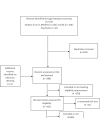Effects of screentime on the health and well-being of children and adolescents: a systematic review of reviews
- PMID: 30606703
- PMCID: PMC6326346
- DOI: 10.1136/bmjopen-2018-023191
Effects of screentime on the health and well-being of children and adolescents: a systematic review of reviews
Abstract
Objectives: To systematically examine the evidence of harms and benefits relating to time spent on screens for children and young people's (CYP) health and well-being, to inform policy.
Methods: Systematic review of reviews undertaken to answer the question 'What is the evidence for health and well-being effects of screentime in children and adolescents (CYP)?' Electronic databases were searched for systematic reviews in February 2018. Eligible reviews reported associations between time on screens (screentime; any type) and any health/well-being outcome in CYP. Quality of reviews was assessed and strength of evidence across reviews evaluated.
Results: 13 reviews were identified (1 high quality, 9 medium and 3 low quality). 6 addressed body composition; 3 diet/energy intake; 7 mental health; 4 cardiovascular risk; 4 for fitness; 3 for sleep; 1 pain; 1 asthma. We found moderately strong evidence for associations between screentime and greater obesity/adiposity and higher depressive symptoms; moderate evidence for an association between screentime and higher energy intake, less healthy diet quality and poorer quality of life. There was weak evidence for associations of screentime with behaviour problems, anxiety, hyperactivity and inattention, poorer self-esteem, poorer well-being and poorer psychosocial health, metabolic syndrome, poorer cardiorespiratory fitness, poorer cognitive development and lower educational attainments and poor sleep outcomes. There was no or insufficient evidence for an association of screentime with eating disorders or suicidal ideation, individual cardiovascular risk factors, asthma prevalence or pain. Evidence for threshold effects was weak. We found weak evidence that small amounts of daily screen use is not harmful and may have some benefits.
Conclusions: There is evidence that higher levels of screentime is associated with a variety of health harms for CYP, with evidence strongest for adiposity, unhealthy diet, depressive symptoms and quality of life. Evidence to guide policy on safe CYP screentime exposure is limited.
Prospero registration number: CRD42018089483.
Keywords: chil health; mental health; obesity; screentime.
© Author(s) (or their employer(s)) 2019. Re-use permitted under CC BY-NC. No commercial re-use. See rights and permissions. Published by BMJ.
Conflict of interest statement
Competing interests: None declared.
References
-
- Klesges RC, Shelton ML, Klesges LM. Effects of television on metabolic rate: potential implications for childhood obesity. Pediatrics 1993;91:281 6. - PubMed
Publication types
MeSH terms
LinkOut - more resources
Full Text Sources
Medical

